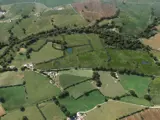Hoscar Habitat Bank, West Lancashire
Local planning authority (LPA): West Lancashire Borough Council
National Character Area (NCA): Lancashire and Amounderness Plain
Biodiversity Units available:
- To be confirmed
Our Hoscar Habitat Bank covers an area of more than 20 hectares in rural West Lancashire. There, we are creating rich wildflower grasslands and enhancing the wet woodland and ditches. The site has been used for arable farming since the 1950s, and we’re now excited to return it to its historic landscape.
Following a thorough assessment of the site's vegetation, wildlife, geology, hydrology, soil chemistry, management history, and landscape connectivity, we determined the best possible habitats to establish and made sure these enhancements would be deliverable. We established an ecological baseline for the site using Defra’s biodiversity metric, so we can clearly demonstrate biodiversity gains over time.
This assessment enables us to generate a range of high-integrity Biodiversity Unit habitat types that will ensure robust ecological outcomes. We also offer planning support to make sure our Biodiversity Units provide an effective local BNG delivery solution for developers within the West Lancashire Borough Council LPA area or Lancashire and Amounderness Plain NCA. Our Units are ready to purchase now, subject to availability.
Adjacent LPAs for cross-boundary coverage:
- Chorley Council
- Fylde Borough Council
- St Helens Borough Council
- South Ribble Borough Council
- Sefton Metropolitan Borough Council
- Wigan Metropolitan Borough Council
- Knowsley Metropolitan Borough Council
Adjacent NCAs for cross-boundary coverage:
- Sefton Coast
- Lancashire Valleys
- Merseyside Conurbation
- Lancashire Coal Measures
- Bowland Fringe and Pendle Hill
- Morecambe Coast and Lune Estuary
The site is strategically located in close proximity to Martin Mere Special Protection Area (SPA) and Ramsar site, designated for its populations of wintering wildfowl and wading birds. We’re really excited for the Habitat Bank to provide shelter for a range of wildlife, including wintering and breeding birds.
Public footpaths are present along the north and west boundary of the site, and this means that the local community will be able to witness as the Habitat Bank develops over the years. It’s fantastic that people living nearby will get to experience the beauty and rich diversity of such an incredible green space as it thrives on their doorstep.
Find out the cost and availability of Biodiversity Units from our Hoscar Habitat Bank





